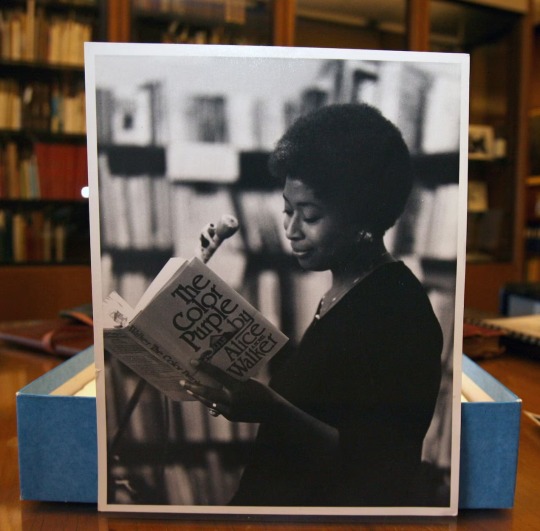#Criticisms | Race | Sex | Abuse | Agony | Spelling | Style
Explore tagged Tumblr posts
Text
Why Parents Still Try to Ban ‘The Color Purple’ in Schools
Four decades after it was released, Alice Walker’s enduring classic remains at the forefront of the battle over what is available on library shelves.
— By Erin Blakemore | August 22, 2023

Alice Walker reads from her Pulitzer Prize- and National Book Award-winning novel, The Color Purple. Since it was first published in 1982, the critically acclaimed book has been targeted by movements pushing to censor the book's subject matter. Photograph By Johnny Crawford, Atlanta Journal-Constitution/AP
When Alice Walker’s The Color Purple hit bookshelves in 1982, it blew away critics, became a nationwide bestseller, and endeared itself to readers who found pain and inspiration in its pages.
But in the years since its publication, the acclaimed novel has become famous for another reason: It’s one of the most challenged books in the nation, withstanding criticisms aimed at its depictions of race and sex, its portrayal of abuse and agony, and even its spelling and style.
Here’s how The Color Purple became one of the nation’s most banned books—and why it continues igniting controversy to this day.
“A Spiritual Experience”
Walker, who grew up in Jim Crow-era Georgia, described writing the book as a “spiritual experience” inspired by the strength and grit of the Black Southern women she made her heroines. The epistolary epic follows 40 years in the lives of its main characters Celie, Shug, and Nettie, who survive incest, domestic abuse, and racism in the early twentieth century—all while carving out joy, independence, and dignity along the way.
When it was released in 1982, the book immediately caught the attention of both the critics and the reading public, who praised the book for its portrayals of both the brutality and sorrow of racism and sexual violence and its celebration of Black women.
It was critically acclaimed, winning both the Pulitzer Prize and National Book Award for 1983, and inspired a popular 1985 film directed by Stephen Spielberg and starring Whoopi Goldberg and Oprah Winfrey.
Banning ‘Purple’
But something else accompanied the novel as its renown grew: controversy. Though educators recognized the book’s potential as a teaching tool, some parents and community members objected to its presence in school curriculums and libraries.
The first major attempt to ban the book occurred in 1984, when a parent petitioned against its use in an Oakland, California classroom. In a 1985 essay, Walker recalled reading frequent updates on “how the banning was coming along” and watching the book’s sales skyrocket.
“I felt I had written the book as a gift to the people. All of them,” Walker wrote. “If they wanted it, let them fight to keep it, as I had to fight to deliver it.”
Fight they did. Though the Oakland schools ultimately decided not to remove the book from classrooms, the book has consistently been challenged nationwide since its publication, repeatedly making it on the American Library Association’s list of most frequently challenged books.
Why Parents Challenge the Book
Attempts to ban The Color Purple usually contest Walker’s use of slang and profanity, the book’s portrayal of brutal Black men, a same-sex encounter between the two main characters, and its depiction of sexual violence in its first pages.
“One can eat from a cafeteria or a dumpster…but one would hope those placed in charge of our children would have exercised better oversight,” wrote one parent in a characteristic 2013 challenge in Brunswick County, North Carolina. (The book has survived multiple attempted bans in the Brunswick County school district.)
But the same pages that provoke ire in some have inspired others.
Oprah Winfrey, who endured sexual abuse as a child, later recalled reading the first page of The Color Purple “and thinking ‘Oh God, I’m not alone.’” After Winfrey co-starred in the first movie adaptation of the film, she began talking about her own experiences on her talk show.
TV historians now credit the self-disclosures inspired by Walker’s book with helping Winfrey develop her winning confessional interview format.
Modern Attempts to Ban the Novel
Efforts to ban The Color Purple have continued during a recent wave of attempted book bans.
In 2022, the American Library Association documented over 1,200 attempts to ban or restrict library materials—double the number of challenges from the previous year—and most of which attempted to remove multiple titles from shelves.
Among them was The Color Purple, which was removed from library shelves in Florida’s Indian County School District at the request of a parent group that objected to 156 of the books on school shelves, claiming the books contain everything from pornography to critical race theory. Though the district’s school board declined to ban The Color Purple, it did remove five of the other books on the list and approve a permission slip allowing parents to restrict their child’s use of school library books.
With news of an upcoming movie adaptation of the acclaimed musical based on the book, The Color Purple is poised to regain the national spotlight. Only time will tell if the movie will spark more challenges—but for now, the legacy of a book one 1982 reviewer called “indelibly affecting” is secure.
To date, the book has sold over 5 million copies—a number sure to rise as a new generation meets its heroines.
#Alice Walker#The Color Purple#Schools#Erin Blakemore#Pulitzer Prize & National Book Award-Winning Novel#Published | 1982#Nationwide Bestseller#Pain | Inspiration#Criticisms | Race | Sex | Abuse | Agony | Spelling | Style#Jim Crow-Era | Georgia#Spiritual Experience#Black Southern Women | Heroines#epistolary | Epic#Characters: Celie | Shug | Nettie#Stephen Spielberg | Whoopi Goldberg | Oprah Winfrey.#Parents | Community Members | Objections#School Curriculums | Libraries.#Oakland Schools#American Library Association#Brunswick County | North Carolina#Florida’s Indian County School District#The Color Purple | 5 Million Copies Sold
10 notes
·
View notes